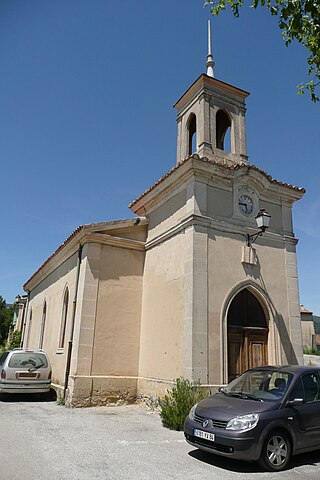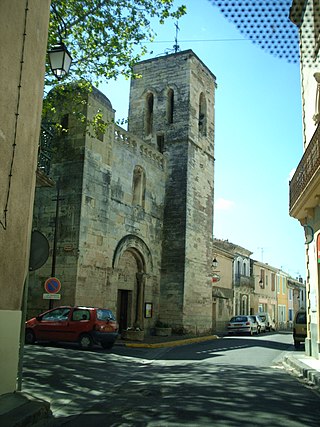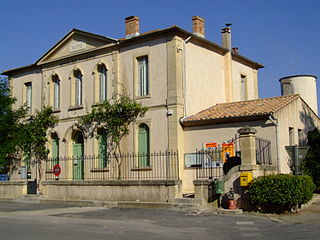
Aigues-Mortes is a commune in the Gard department in the Occitania region of southern France. The medieval city walls surrounding the city are well preserved. Situated on the junction of the Canal du Rhône à Sète and the Chenal Maritime to Le Grau-du-Roi, the town is a transit center for canal craft and Dutch barges.

Gard is a department in Southern France, located in the region of Occitanie. It had a population of 748,437 as of 2019; its prefecture is Nîmes.

The arrondissement of Nîmes is an arrondissement of France in the Gard department in the Occitanie region. It has 180 communes. Its population is 554,624 (2016), and its area is 3,158.1 km2 (1,219.3 sq mi).

La Motte-d'Aigues is a commune in the Vaucluse department in the Provence-Alpes-Côte d'Azur region in southeastern France.

Aimargues is a commune in the Gard department in southern France. The town of Aimargues may have Roman origins and is situated beside the river Vidourle on the floodplain of the Rhône. Traditionally it has been an agricultural and wine-producing community but it now also has a number of new industries and employers who benefit from excellent road connections to the north of France as well as to Spain and Italy.

Le Grau-du-Roi is a commune in the Gard department in southern France. It is the only commune in Gard to have a frontage on the Mediterranean. To the west is the Herault department and La Grande-Motte village, and to the east is the Bouches-du-Rhone department. Using the sea as a vantage point, the commune has four distinct sections: the right beach, the Village, the left beach, Port-Camargue and L'Espiguette. Immediately landwards are the large shallow étangs, saline marshes, which separate it from Aigues Mortes, a neighboring mediaeval walled city that used to be a port. The étangs are home to numerous flamingoes.

Gallargues-le-Montueux is a commune in the Gard department in southern France.

Le Cailar is a commune in the Gard department in southern France. It is located at the confluence of the River Vistre and the River Rhôny. It was an important port during the Iron Age at a time when lagoons connected to the Mediterranean Sea covered the adjoining low-lying land.

Villevieille is a commune in the Gard department in southern France.

Pujaut is a commune in the Gard department in southern France. The village is situated on the south side of a small hill overlooking a flat plain that once formed the bed of a lake. The lake was drained at the beginning of the 17th century. The village is located 3.5 km west of the Rhône, 4.5 km north of Villeneuve-lès-Avignon and 5 km south of Roquemaure. In 2017 the commune had a population of 4,136.

Aigne is a commune in the Hérault department in the Occitanie region of southern France.

Aigues-Vives is a commune in the Ariège department in the Occitanie region of southwestern France.

Aigues-Vives is a commune in the Aude department in the Occitanie region of southern France.

Badens is a commune in the Aude department in the Occitanie region of southern France.
Cabrerolles is a commune in the Hérault department in southern France.

Vérargues is a former commune in the Hérault department in the Occitanie region in southern France. On 1 January 2019, it was merged into the new commune Entre-Vignes.

Aigues-Vives is a commune in the Hérault department in the Occitanie region in southern France.
The canton of Aigues-Mortes is an administrative division of the Gard department, southern France. Its borders were modified at the French canton reorganisation which came into effect in March 2015. Its seat is in Aigues-Mortes.

The Aigues-Vives tramway was a 2 km (1.2 mi) long narrow-gauge railway with a gauge of 600 mm in Aigues-Vives in the department Gard in Southern France. It operated from 1892 to 1901.

Toni Grand was a French sculptor. In his early career he was associated with the Supports/Surfaces group. He represented France at the 1982 Venice Biennale and his work has been shown in major museums.






















